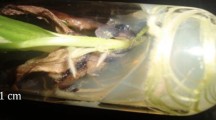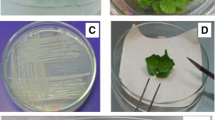Abstract
Hairy roots of Nasturtium officinale, Barbarea verna and Arabis caucasica with active glucosinolate-myrosinase system were obtained after transformation with Agrobacterium rhizogenes. Hairy roots of N. officinale produced phenylalanine-derived gluconasturtiin and glucotropaeolin (max. 24 and 7 mg g−1 DW). B. verna and A. caucasica hairy roots produced gluconasturtiin (max. 41 mg g−1 DW) and methionine-derived glucoiberverin (max. 32 mg g−1 DW), respectively. Treatment of the roots with amino acid precursors of glucosinolate or/and cysteine biosynthesis increased levels of glucosinolate production, combinations of phenylalanine with cysteine (for gluconasturtiin and glucotropaeolin) and methionine with o-acetylserine (for glucoiberverin) were the most effective.
Similar content being viewed by others
Avoid common mistakes on your manuscript.
Introduction
Glucosinolates are l-amino acid-derived β-thioglucoside-N-hydroxysulfates present in sixteen plant families, which upon hydrolysis by endogenous enzyme myrosinase (β-thioglucosidase, EC 3.2.3.1) are converted into bioactive compounds, including isothiocyanates. Isothiocyanates can be toxic or growth-suppressing to fungi, bacteria, insects, and nematodes (see Fahey et al. 2001 for review) and they have been shown to prevent the initiation of cancer in humans, especially induced by chemical carcinogens (see Hayes et al. 2008 for review). Since most plants produce the mixture of glucosinolates, the need for testing activity of pure compounds has increased interest in searching for rich sources of single glucosinolates both in plants and in plant in vitro cultures. We have already established hairy root cultures of Tropaeolum majus that are able to produce glucotropaeolin, myrosinase and benzyl isothiocyanate. We have also reported a method to stimulate glucotropaeolin production by precursor amino acids (Phe, Cys) and elicitors (Wielanek and Urbanek 2006). The aim of this present work was to obtain hairy root cultures of Nasturtium officinale, Barbarea verna and Arabis caucasica with active glucosinolate-myrosinase system, and to study the influence of individual or combined treatment with amino acid precursors of glucosinolates (Phe, Met, Cys) and cysteine (Ser, AOS) biosynthesis on glucosinolate and isothiocyanate production.
Materials and methods
Hairy roots were obtained after transformation of aseptically grown seedlings of N. officinale R.Br., B. verna (Mill.) Asch. and Ar. caucasica L. with Agrobacterium rhizogenes LBA 9402 (pRi 1855). The roots were cultured on B5 medium (Gamborg et al. 1968) containing 3% (w/v) sucrose and 0.02% (w/v) peptone from casein (pH 5.8), on the orbital shaker (120 rpm), in the dark, at 24°C, and subcultured every 4 weeks. Genomic DNA was isolated with the use of CTAB/PVP method (Pirtillä et al. 2001). To determine the presence of Ri T-DNA in the hairy roots genome, the polymerase chain reaction (PCR) was performed using as a target DNA isolated from untransformed and transformed roots of N. officinale, B. verna, Ar. caucasica (Królicka et al. 2001). To confirm that the hairy root cultures of N. officinale, B. verna, Ar. caucasica were free from Agrobacterium rhizogenes, a PCR with primers homologous to the sequence of virG gene, which is localized beside T-DNA region of Ri plasmid, was performed (Aoyama et al. 1989).
Concentrations of the used precursors were selected on the basis of the previous experiments (data not shown). Phe, Cys, Met, Ser, OAS (O-acetyl-l-serine) were dissolved in water and sterilized (0.22 μM filter). The concentrated solutions (pH 5.8) were added, alone or in the mixture, to the 12-day-old cultures to obtain 0.5 mM of each precursor. The material from two flasks was collected on the 10th day after treatment (22nd day of culture) for analysis of glucosinolate content, myrosinase activity and isothiocyanate production.
Glucosinolates were extracted, purified and analyzed according to Wielanek and Urbanek (2006). The identification of intact glucotropaeolin, gluconasturtiin and glucoiberverin was performed by HPLC. Glucosinolate content was expressed as mg g−1 dry weight (DW), based on the calibration curve for standards.
Myrosinase was extracted and analyzed according to the method of Wielanek and Urbanek (2006). Myrosinase activity was expressed in μmol min−1 (U) mg−1 protein determined by Bradford’s method.
Endogenous hydrolysis and isothiocyanate extraction was performed according to the modified method of Sultana et al. (2002). Hairy roots (10 g fresh weight, FW) were homogenized with 50 mM sodium phosphate buffer pH 7.5 (1:20, w/v) then placed on the rotary shaker in 37°C; autolysis was conducted for 30 min after that liquid paraffin was added and hydrolysis was continued for the next 30 min. The paraffin oil extraction was repeated two times. The collected paraffin layers were partitioned three times against methanol not shaking (30 min). The methanol layers were evaporated under reduced pressure, the residues were dissolved in acetonitrile, and the identification of benzyl phenylethyl and 3-(methylthiopropyl) isothiocyanates was performed by HPLC. Isothiocyanate content was expressed as mg 10 g−1 FW based on the calibration curve for standards.
Results and discussion
Several clones of N. officinale, B. verna and Ar. caucasica hairy roots were obtained (Table 1). DNA isolated from the root clones was used as a target in PCR with primers designed to be complementary to rolB and rolC genes (Królicka et al. 2001). The primers generated amplification products of approximately 423 and 626 bp with target DNA isolated from all hairy roots whereas DNA from untransformed roots did not act as a template for these primers (Fig. 1). The amplification product of virG gene was observed only in the case of DNA isolated from Ag. rhizogenes LBA 9402 strain (Fig. 1, line 19). The results indicate that rolB and rolC genes from Ri plasmid of Ag. rhizogenes LBA 9402 became integrated with the genome of N. officinale, B. verna and Ar. caucasica hairy roots.
PCR analysis of N. officinale (lanes 1–5), B. verna (6–10) and Ar. caucasica (11–15) roots transformed by A. rhizogenes LBA9402 (1, 3, 6, 8, 11, 13) and untransformed (2, 4, 7, 9, 12, 14); A. rhizogenes LBA9402 as a positive control (17–19). Lanes 5, 10, 15: hairy roots + virG as a negative control. Lanes M: GeneRuler™ 100 bp DNA ladder. Arrows show amplified fragments of rolB (423 bp), rolC (626 bp) and virG (350 bp) genes
HPLC analyses of intact glucosinolate indicated that the obtained hairy roots were able to synthesise gluconasturtiin (N. officinale and B. verna), glucotropaeolin (N. officinale), and glucoiberverin (Ar. caucasica) (Fig. 2) and glucosinolate biosynthesis was associated with myrosinase activity (Table 1). In all of the cultures increase in glucosinolate content and myrosinase activity was accompanied by the phase of biomass growth reaching the maximum on the 22nd day when the roots started to enter stationary phase of growth (Fig. 3).
Paired-ion chromatography of intact glucosinolates from hairy roots. Standards: 1, glucoiberverin; 2, sinigrin; 3, sinalbin; 4, glucotropaeolin; 5, gluconasturtiin. HPLC performed on Hypersil Gold C18 RP column (250 × 4.6 mm, 5 μm) coupled to an ODS Hypersil guard column (10 × 3 mm, 5 μm), developed isocratically with H2O/acetonitrile (50:50, v/v) containing 5 mM tetradecyloammonium bromide, flow rate 3 cm3 min−1, at 229 nm
Our experiments with T. majus hairy roots (Wielanek and Urbanek 2006), as well as data from the studies with suspension cultures of Nasturtium montanum and Cleome chelidonii (Songsak and Lockwood 2004) indicated the stimulating effect of the amino acid precursors on glucosinolate and isothiocyanate production. Biosynthesis of glucotropaeolin and gluconasturtiin depends on Phe, glucoiberverin is Met-derived, Cys is a source of sulfur in β-d-thioglucoside moiety of all glucosinolates (Du and Halkier 1996; Wallsgrove et al. 1999; Campos de Quiros et al. 2000). Cys is the product of cysteine synthase complex catalyzing sulfide incorporation into Ser-derived O-acetyl-l-serine (OAS), and then Met, via a trans-sulfuration, is derived from Cys (Wirtz and Droux 2005). The influence of the abovementioned amino acid on glucosinolate and isothiocyanate production was studied in NO-6, BV-4 and AC-1 clones with the highest glucosinolate content (Table 1). Treatment of the cultures with the precursors, either individually or in combination, enhanced glucosinolate content (see Fig. 4), the most effective were Phe + Cys and Met + OAS combinations, which resulted in increased isothiocyanates production in the autolysates of the treated hairy roots.
Effect of amino acid precursors (0.5 mM applied alone or in combination) on glucosinolate content, isothiocyanate yield and myrosinase activity on the 22nd day of culture (10 days after treatment) of hairy root clones of N. officinale (NO-6), B. verna (BV-4) and Ar. caucasica (AC-1): BITC, benzyl isothiocyanate; MtpITC, 3-(methylthio)propyl isothiocyanate; PeITC, 2-phenylethyl isothiocyanate. HPLC determination of isothiocyanates was performed on a Hypersil Gold C18 RP column (250 × 4.6 mm, 5 μm) coupled to an ODS Hypersil guard column (10 × 3 mm, 5 μm), with H2O/acetonitrile (49:51v/v), at 0.8 cm3 min−1, and monitoring at 246 nm. Presented data are means (±SD) of three independent experiments
Hairy roots of B. verna and Ar. caucasica with active glucosinolate-myrosinase system can be used both as experimental models and as a rich sources of gluconasturtiin and glucoiberverin, respectively as the single glucosinolate, and of their bioactive derivatives—isothiocyanates. Availability of precursor amino acids seemed to be a factor limiting glucosinolate and isothiocyanate production in the studied hairy roots.
References
Aoyama T, Hirayama T, Tamamoto S, Oka A (1989) Putative start codon TTG for the regulatory protein VirG of the hairy-root-inducing plasmid pRiA4. Gene 78:173–178
Campos de Quiros H, Magrath R, McCallum D, Kroymann J, Scnabelrauch D, Mithell-Olds T, Mithen R (2000) α-Keto acid elongation and glucosinolate biosynthesis in Arabidopsis thaliana. Theor Appl Genet 101:429–437
Du L, Halkier BA (1996) Isolation of microsomal enzyme system involved in glucosinolate biosynthesis from seedlings of Tropaeolum majus L. Plant Physiol 111:831–837
Fahey JW, Zalcmann AT, Talalay P (2001) The chemical diversity and distribution of glucosinolates and isothiocyanates among plants. Phytochemistry 56:5–51
Gamborg OL, Miller RA, Ojima K (1968) Nutrient requirements of suspension cultures of soybean root cells. Exp Cell Res 50:151–158
Hayes JD, Kelleher MO, Eggleston IM (2008) The cancer chemopreventive actions of phytochemicals derived from glucosinolates. Eur J Nutr 47:73–88
Królicka A, Staniszewska I, Bielawski K, Maliński E, Szafranek J, Łojkowska E (2001) Establishment of hairy root cultures of Ammi majus. Plant Sci 160:259–264
Pirtillä AM, Hirsikorpi M, Kämäräinen T, Jaakola L, Hohtola A (2001) DNA isolation methods for medicinal and aromatic plants. Plant Mol Biol Rep 19:273a–273f
Songsak T, Lockwood GB (2004) Production of two volatile glucosinolate hydrolysis compounds in Nasturtium montanum and Cleome chelidonii plant cell cultures. Fitoterapia 75:296–301
Sultana T, Savage GP, McNeil DL, Porter NG, Martin RJ, Deo B (2002) Effects of fertilization on the allyl isothiocyanate profile of above-ground tissues of New Zealand-grown wasabi. J Sci Food Agric 82:1477–1482
Wallsgrove RM, Bennett RN, Doughty K (1999) Glucosinolates. In: Singh BK (ed) Plant amino acids: biochemistry and biotechnology. Marcel Dekker, New York, pp 523–562
Wielanek M, Urbanek H (2006) Enhanced glucotropaeolin production in hairy root cultures of Tropaeolum majus L. by combining elicitation and precursor feeding. Plant Cell Tissue Organ Cult 86:177–186
Wirtz M, Droux M (2005) Synthesis of the sulfur amino acids: cysteine and methionine. Photosynth Res 86:345–362
Acknowledgements
This work was partly supported by The State Committee for Scientific Research Grant No. 2P04C 003 2 and by University of Łódź Grant No. 506/819.
Author information
Authors and Affiliations
Corresponding author
Rights and permissions
About this article
Cite this article
Wielanek, M., Królicka, A., Bergier, K. et al. Transformation of Nasturtium officinale, Barbarea verna and Arabis caucasica for hairy roots and glucosinolate-myrosinase system production. Biotechnol Lett 31, 917–921 (2009). https://doi.org/10.1007/s10529-009-9953-0
Received:
Accepted:
Published:
Issue Date:
DOI: https://doi.org/10.1007/s10529-009-9953-0








